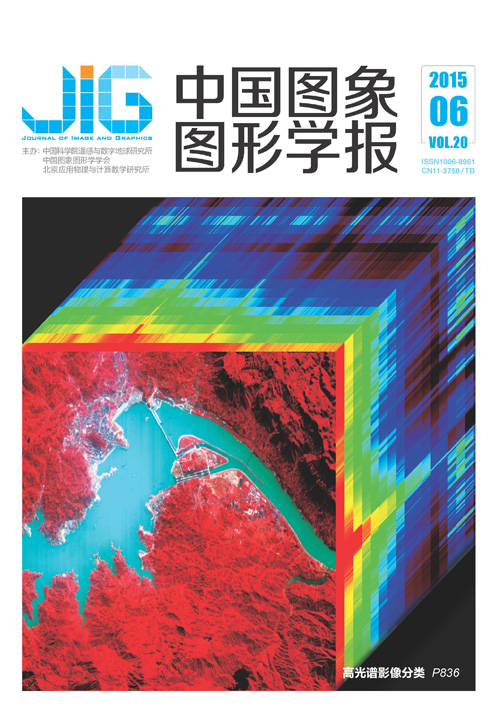
倾斜航空影像的城区DSM生成
摘 要
目的 以五方向倾斜航空影像为数据源开展城市数字表面模型(UDSM)半全局匹配(SGM)生成研究.方法 主要包括两方面:1) 路径受限的SGM金字塔匹配.以数量众多、分布均匀的倾斜影像空中三角测量连接点为约束对SGM匹配代价路径进行分段“纠正”,以连接点薄板样条变换(TPS)生成的良好初始视差为基础实施金字塔匹配,提高SGM可靠性并实现路径搜索加速;2) 基于遮挡分析的UDSM多视融合.以倾斜影像垂直视图UDSM为主体,将其他视图UDSM投影到垂直视图进行遮挡判断并根据其投影坐标分成3部分:遮挡点集、与垂直UDSM重叠的冗余点集、与垂直UDSM无重叠的非冗余点集,其中经过有效范围剔除的遮挡点集和非冗余点集将用于弥补垂直UDSM在立面或地面局部遮挡区域缺失的空间信息.结果 针对某城市局部区域的UDSM生成实验显示,对存在透视失真、遮挡及不同基线条件的五方向倾斜航空像对,本文方法匹配生成的各像对UDSM质量均比传统SGM算法表现出色,融合后的UDSM点云分布更均匀、空间信息更完整,明显优于传统UDSM.结论 以空中三角测量可靠连接点为路径约束并采用具有增大“拉入”范围能力的金字塔匹配策略,较好地解决了SGM因倾斜影像透视失真严重,视差搜索范围大而导致的匹配代价函数局部最优,错误匹配沿代价路径向后传播以及实时存储、计算开销大等应用问题,保障了倾斜影像的高质量密集匹配并明显提升计算效率;以垂直视图为主体的UDSM多视融合遮挡分析,充分考虑了同一目标区域多视UDSM空间信息既互补又存在高度冗余的特点,在有效去除冗余点云的同时,利用4个不同视图方向的UDSM来弥补垂直UDSM在立面以及局部地面、建筑物屋顶面空间信息的不足,为后续城市“真”正射影像制作及3维城市建模奠定了基础.
关键词
Automatic generation of high-quality urban DSM with airborne oblique images
Wu Jun, Cheng Menmen, Yao Zexin, Peng Zhiyong, Li Jun, Ma Jun(School of Electrical Engineering and Automation Guilin University of Electronic Technology, Guilin 541004, China) Abstract
This research applies the semi-global matching (SGM) algorithm to generate high-quality urban digital surface models (UDSMs) with airborne oblique images. Objective The oblique photogrammetry system (OPS) was influenced by and significantly affected photogrammetry. Thus, OPS can act as a good image source for generating high-quality UDSMs. UDSMs are more appealing than traditional DSMs to users due to the following advantages: 1) UDSMs comprehensively describe 3D urban surfaces. Therefore, inclined oblique images that are originally designed to determine the textures of overall buildings textures effectively solve the problem of the current DSM product involving space information loss at urban building facades. 2) Image matching and space interpretation are highly reliable in UDSMs. Similar targets, such as building roofs and floors, are often observed in multiple oblique stereo images with different title angles and baseline conditions. Thus, strong constraints based on redundant information can be used to either filter UDSM “noise” or remove false image matches effectively. 3) In UDSMs, the aerial solution to image occlusion is low-cost. Severe collisions usually occur among buildings in the aerial images of urban regions. The traditional solution to aerial photography occlusion involves increasing the degree of overlap among images at the cost of dense flights. This process ensures that the occlusion region is “visualized” in different images. The OPS itself considers the omnibearing observation of the urban scene; therefore, the occluded urban regions can be determined at minimal cost with this system. However, oblique image processing is challenging in terms of automation and quality. For instance, the stereo matching of oblique images is subject to various obstacles, such as significant illumination differences, severe occlusions, discontinuous object boundaries, and low or repetitive textures. To address such problems, a new approach is proposed based on the improved SGM algorithm and perspective projection-induced, multi-view UDSM fusion to generate UDSMs from airborne oblique images. Method The proposed approach is composed of two stages: 1) path-constrained SGM pyramid matching, in which the SGM algorithm is applied to oblique images that are subject to severe perspective distortion and long-range disparity search. To this end, reliable tie points from photogrammetry automatic triangulation (AAT) are used as unchanged “anchors” to block the propagation of SGM mistakes along the cost path. An effective initial disparity map is generated from these tie points through thin-plate spline transformation for implementing the pyramid version of SGM.2) Multi-view UDSM merging based on perspective occlusion judgment, where UDSM point clouds from the titular oblique view are projected onto the nadir image for occlusion judgment and overlap test. As a result, projected UDSMs are classified into occlusion, redundant, and non-redundant collections. A UDSM is obtained with complete space information by removing redundant point clouds from the titular oblique UDSMs and by merging the remaining point clouds with nadir UDSMs.Result Five airborne oblique stereo images are derived from OPS, and cameras are positioned in the configuration of a Maltese cross. The selected images are tested using the proposed approach to generate UDSMs for local urban regions. The proposed approach not only generated a dense disparity map for each oblique stereo image more effectively than the original SGM algorithm did, but the method also produced high-quality UDSMs that describe 3D urban surfaces more completely than traditional UDSMs.Conclusion The following results are obtained: (1) the incorporation of constraints from reliable AAT tie points and the implementation of pyramid matching improve SGM performance with respect to the dense matching of airborne oblique images. In particular, this improvement is observed with regard to blocking the propagation of SGM mistakes along the cost path, reducing search range disparities, and saving on-line memory requirements. As a result, a high-quality disparity map can be produced at low computational cost. (2) As per the analysis of perspective projection, most building facades and occluded ground surfaces can be extracted automatically from four titled UDSMs. This process compensates for the deficiencies of nadir UDSMs while removing redundant point clouds simultaneously. As a result, high-quality UDSMs can be generated that describe 3D urban surfaces completely. These findings act as a foundation for actual orthoimage generation and 3D city modeling.
Keywords
|



 中国图象图形学报 │ 京ICP备05080539号-4 │ 本系统由
中国图象图形学报 │ 京ICP备05080539号-4 │ 本系统由